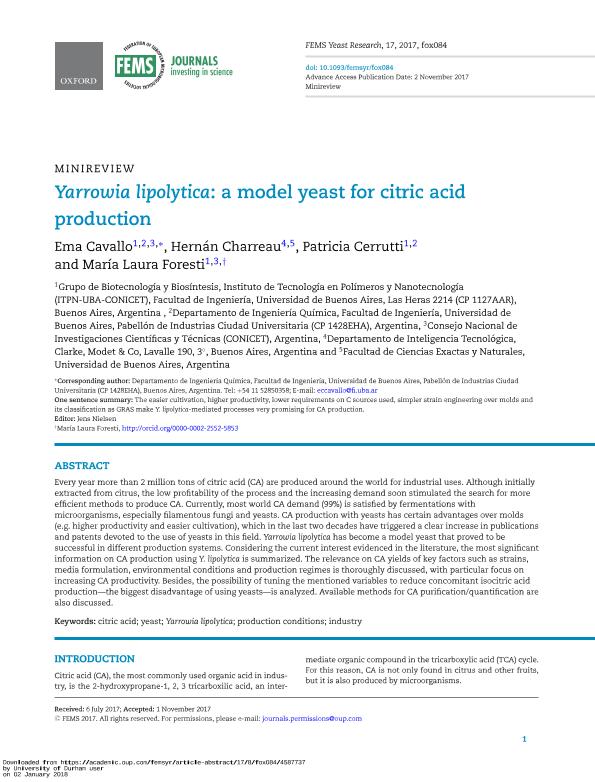Mostrar el registro sencillo del ítem
dc.contributor.author
Cavallo, Ema Claudia

dc.contributor.author
Charreau, Hernán
dc.contributor.author
Cerrutti, Patricia

dc.contributor.author
Foresti, María Laura

dc.date.available
2018-12-05T18:27:58Z
dc.date.issued
2017-12
dc.identifier.citation
Cavallo, Ema Claudia; Charreau, Hernán; Cerrutti, Patricia; Foresti, María Laura; Yarrowia lipolytica: A model yeast for citric acid production; Wiley Blackwell Publishing, Inc; Fems Yeast Research; 17; 8; 12-2017; 1-16
dc.identifier.issn
1567-1356
dc.identifier.uri
http://hdl.handle.net/11336/65884
dc.description.abstract
Every year more than 2 million tons of citric acid (CA) are produced around the world for industrial uses. Although initially extracted from citrus, the low profitability of the process and the increasing demand soon stimulated the search for more efficient methods to produce CA. Currently, most world CA demand (99%) is satisfied by fermentations with microorganisms, especially filamentous fungi and yeasts. CA production with yeasts has certain advantages over molds (e.g. higher productivity and easier cultivation), which in the last two decades have triggered a clear increase in publications and patents devoted to the use of yeasts in this field. Yarrowia lipolytica has become a model yeast that proved to be successful in different production systems. Considering the current interest evidenced in the literature, the most significant information on CA production using Y. lipolytica is summarized. The relevance on CA yields of key factors such as strains, media formulation, environmental conditions and production regimes is thoroughly discussed, with particular focus on increasing CA productivity. Besides, the possibility of tuning the mentioned variables to reduce concomitant isocitric acid production-the biggest disadvantage of using yeasts-is analyzed. Available methods for CA purification/quantification are also discussed.
dc.format
application/pdf
dc.language.iso
eng
dc.publisher
Wiley Blackwell Publishing, Inc

dc.rights
info:eu-repo/semantics/openAccess
dc.rights.uri
https://creativecommons.org/licenses/by-nc-sa/2.5/ar/
dc.subject
Citric Acid
dc.subject
Industry
dc.subject
Production Conditions
dc.subject
Yarrowia Lipolytica
dc.subject
Yeast
dc.subject.classification
Biotecnología Industrial

dc.subject.classification
Biotecnología Industrial

dc.subject.classification
INGENIERÍAS Y TECNOLOGÍAS

dc.title
Yarrowia lipolytica: A model yeast for citric acid production
dc.type
info:eu-repo/semantics/article
dc.type
info:ar-repo/semantics/artículo
dc.type
info:eu-repo/semantics/publishedVersion
dc.date.updated
2018-10-23T19:48:07Z
dc.journal.volume
17
dc.journal.number
8
dc.journal.pagination
1-16
dc.journal.pais
Reino Unido

dc.journal.ciudad
Londres
dc.description.fil
Fil: Cavallo, Ema Claudia. Consejo Nacional de Investigaciones Científicas y Técnicas. Oficina de Coordinación Administrativa Houssay. Instituto de Tecnología en Polímeros y Nanotecnología. Universidad de Buenos Aires. Facultad de Ingeniería. Instituto de Tecnología en Polímeros y Nanotecnología; Argentina. Universidad de Buenos Aires. Facultad de Ingeniería. Departamento de Ingeniería Química; Argentina
dc.description.fil
Fil: Charreau, Hernán. Departamento de Inteligencia Tecnologica; Argentina. Universidad de Buenos Aires. Facultad de Ciencias Exactas y Naturales; Argentina
dc.description.fil
Fil: Cerrutti, Patricia. Consejo Nacional de Investigaciones Científicas y Técnicas. Oficina de Coordinación Administrativa Houssay. Instituto de Tecnología en Polímeros y Nanotecnología. Universidad de Buenos Aires. Facultad de Ingeniería. Instituto de Tecnología en Polímeros y Nanotecnología; Argentina. Universidad de Buenos Aires. Facultad de Ingeniería. Departamento de Ingeniería Química; Argentina
dc.description.fil
Fil: Foresti, María Laura. Consejo Nacional de Investigaciones Científicas y Técnicas. Oficina de Coordinación Administrativa Houssay. Instituto de Tecnología en Polímeros y Nanotecnología. Universidad de Buenos Aires. Facultad de Ingeniería. Instituto de Tecnología en Polímeros y Nanotecnología; Argentina
dc.journal.title
Fems Yeast Research

dc.relation.alternativeid
info:eu-repo/semantics/altIdentifier/doi/https://dx.doi.org/10.1093/femsyr/fox084
dc.relation.alternativeid
info:eu-repo/semantics/altIdentifier/url/https://academic.oup.com/femsyr/article/17/8/fox084/4587737
Archivos asociados
